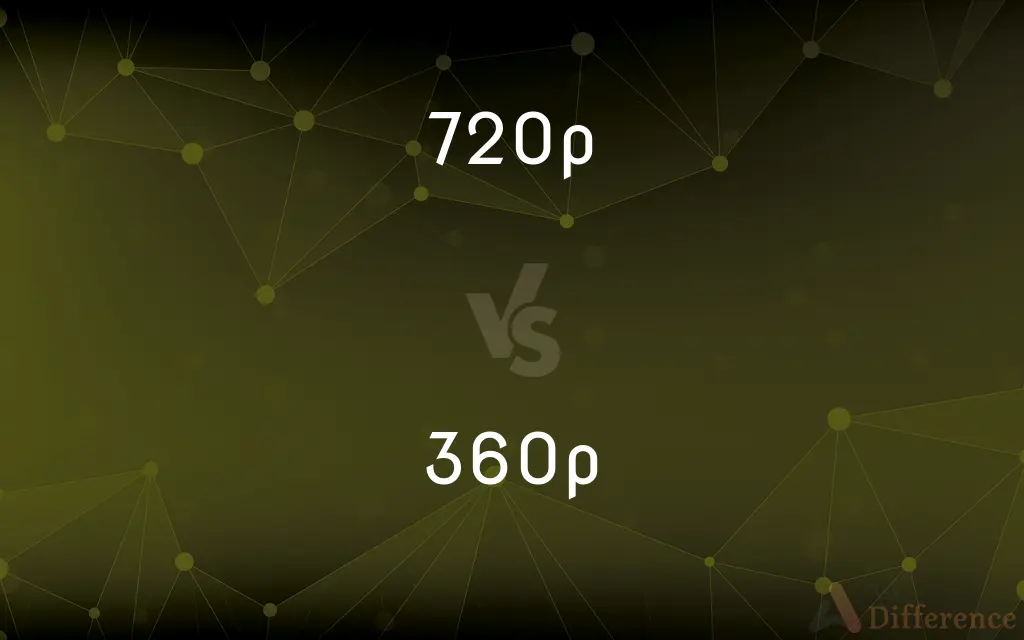720p vs. 360p — What's the Difference?
By Tayyaba Rehman — Published on October 18, 2023
720p refers to HD resolution with 720 pixels vertically; 360p is lower, standard resolution with 360 vertical pixels.

Difference Between 720p and 360p
Table of Contents
ADVERTISEMENT
Key Differences
When contrasting 720p and 360p, the primary differentiation is the resolution or picture clarity they provide. 720p is considered a high-definition resolution, denoted by a display resolution of 1280x720 pixels, rendering it suitable for rendering more detailed and sharp imagery. This resolution is a prominent choice for various mediums such as online streaming, gaming, and television broadcasting due to its balanced compromise between quality and bandwidth consumption.
Conversely, 360p represents a standard definition resolution, symbolizing a display resolution of 640x360 pixels. This lower resolution translates to less detailed and less sharp visuals, often resulting in a pixelated image, particularly on larger displays. However, the advantage of 360p is its lower demand for bandwidth and storage space, making it a viable option for users with limited internet speed or data availability.
The experience provided by 720p is significantly superior due to its ability to deliver clearer and more detailed images, enhancing user engagement and satisfaction, particularly in content consumption and gaming. It is, therefore, a favored resolution for situations where higher quality is desired and bandwidth is available.
However, 360p continues to retain its relevance, especially in scenarios where bandwidth is constrained, or quick loading is pivotal. Despite its inferior quality, 360p is crucial for accessibility, ensuring content reaches a wider audience, regardless of their internet capabilities.
In essence, the choice between 720p and 360p hinges on the trade-off between image quality and resource utilization. 720p is preferable for quality, while 360p is optimal for limited resources and accessibility.
ADVERTISEMENT
Comparison Chart
Resolution
High Definition (1280x720 pixels)
Standard Definition (640x360 pixels)
Detail
Offers more detail and sharpness.
Offers less detail, images may be pixelated.
Bandwidth Consumption
Requires more bandwidth.
Requires less bandwidth.
Storage Space
Consumes more storage space.
Consumes less storage space.
Use Case
Suitable for HD broadcasting and online streaming.
Suitable for limited internet speed or data availability.
Compare with Definitions
720p
720p is a high-definition video mode characterized by 720 lines of vertical resolution.
The video on YouTube was available in 720p, offering a clear and sharp image.
360p
360p, despite its lower quality, ensures wider accessibility.
Providing videos in 360p ensures that users with all types of internet speeds can access the content.
720p
720p videos consume more storage space due to higher resolution.
I had to clear some space on my device to download the movie in 720p.
360p
360p is optimal for users with limited bandwidth or slow internet connections.
Those with slower internet speeds may have to opt for 360p to avoid continuous buffering.
720p
720p represents a resolution of 1280x720 pixels.
For my online streaming, I prefer to watch videos in 720p for better quality.
360p
360p videos consume less storage space and are quicker to load.
I downloaded the tutorial in 360p so it didn't take up much space on my device.
720p
720p is suitable for scenarios where high image quality is crucial, like gaming and HD broadcasting.
Most gamers prefer playing games in at least 720p to enjoy detailed graphics.
360p
360p is a standard-definition video mode characterized by 360 lines of vertical resolution.
To save data, I often watch YouTube videos in 360p.
720p
720p demands higher bandwidth compared to lower resolutions.
Streaming in 720p requires a stable and fast internet connection to avoid buffering.
360p
360p represents a resolution of 640x360 pixels.
The video was only available in 360p, making the image look pixelated on my large screen.
Common Curiosities
What does 720p represent?
720p represents a high-definition resolution of 1280x720 pixels.
How does 360p compare to 720p in terms of quality?
360p has lower quality compared to 720p, with a resolution of 640x360 pixels, offering less detail and sharpness.
Why would someone choose 720p?
People choose 720p for its clearer and more detailed image quality, suitable for HD broadcasting and streaming.
When is 360p typically used?
360p is used when there is limited internet speed or data availability, or quick loading is required.
Share Your Discovery

Previous Comparison
Kappa vs. Nupe
Next Comparison
Nurturing vs. SympatheticAuthor Spotlight
Written by
Tayyaba RehmanTayyaba Rehman is a distinguished writer, currently serving as a primary contributor to askdifference.com. As a researcher in semantics and etymology, Tayyaba's passion for the complexity of languages and their distinctions has found a perfect home on the platform. Tayyaba delves into the intricacies of language, distinguishing between commonly confused words and phrases, thereby providing clarity for readers worldwide.
















































